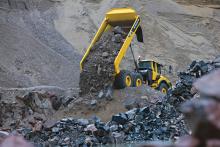
The search for alternative power sources for construction equipment is nothing new. Mike Woof takes a look at Euclid's attempt at using gas turbines
The off-highway equipment sector has seen many interesting and innovative machines over the years, with some seeing meteoric rises in sales and others sinking into obscurity without trace. One of the oddest heavy haulers of all time had to be Euclid's R210 truck, and it certainly falls into the latter category.
This radical design was developed in answer to the shortcomings of available diesel engines of the period. As truck payloads and capacities had grown larger, manufacturers had hit a barrier with the non-availability of high-speed diesels to power these machines. There were also shortcomings with the available tyres on the market, which were not able to offer greater payloads.
To deal with the power problems some truck builders turned to large and heavy low-speed locomotive diesels to drive their large machines, with limited success. The duty cycle of a rail locomotive is somewhat different from that of a haul truck running on-site and these diesels offered limited speed range and poor acceleration while the locomotive engines were also enormously heavy, which restricted payload.
"As truck payloads and capacities had grown larger, manufacturers had hit a barrier with the non-availability of high-speed diesels to power these machines"
Euclid's idea was to move away from the internal combustion engine altogether and the R210 was powered by an Avro-Lycoming gas turbine (originally developed for aviation purposes) delivering 1380kW. The innovations continued throughout the truck's design, which had four wheel drive and steered due to an articulated chassis. Twinned tyres were used too as an answer to the limitations of the products available at that time.
Whether it was a coincidence that Belarus-based Belaz unveiled a prototype gas turbine shortly after has never been properly explained. The Belaz machine also featured an articulated chassis, a configuration used on a machine that was later built in a short production run, although with power from a low speed locomotive diesel.
On-site testing of Euclid's R210 soon revealed the shortcomings of the turbine as a powerplant for an off-highway application. Similar shortcomings had also been seen by automotive manufacturers, such as UK firm Rover and US company
Gas turbines are highly suitable for aviation purposes but work best at optimum speeds and do not offer the responsive acceleration and deceleration of an internal combustion engine, limiting their suitability for vehicles expected to stop and start regularly. To give a turbine truck the acceleration profiles and operating speed range required, a sophisticated gearbox would have been needed. While continuously variable transmissions (CVTs) are being used now in some vehicles and could in theory allow a turbine to be used, these were not on the market in the 1970s. And even now, it is questionable whether a CVT could be manufactured that would be able to cope with the torque output of an aviation turbine as well as deliver the speed range needed for an off-highway hauler, without paying an enormous weight penalty.
There were other problems too, for which answers have not been found. Gas turbines also generate huge quantities of heat and while dispersing this is not a problem for a fast moving aircraft, it is an issue for a much slower wheeled vehicle. Given that even diesel powered trucks can overheat and catch fire from time to time, with disastrous results, there would be serious safety concerns over a heat generating, kerosene fuelled-truck operating on-site.
But cost was the main factor that halted development of the gas turbine truck. Turbines have to be made from rare alloys and are built to precise tolerances, so on-site repairs would have been difficult. Dust ingress can cause even more damage to a turbine than to an internal combustion engine. Gas turbines are also expensive to buy and extremely thirsty and it is of note that the R210 was developed before the oil crisis of the early 1970s. This was a time when fuel prices spiralled rapidly and the turbine in the R210 would have been very costly indeed to run.
The final blow to the turbine concept was when technology moved on with the development of larger high speed diesels (as well as larger tyre sizes). This resulted in Euclid's R210, with its turbine powerplant, becoming a technological blind alley.










